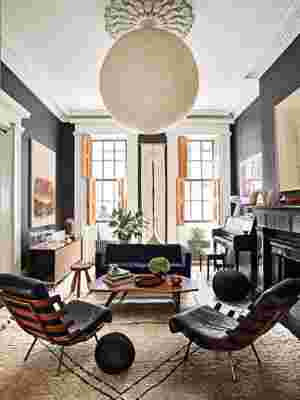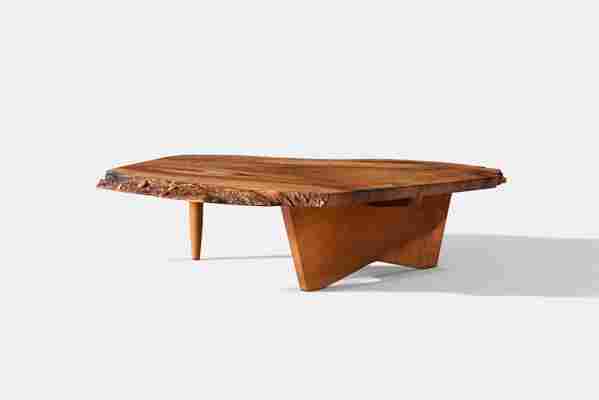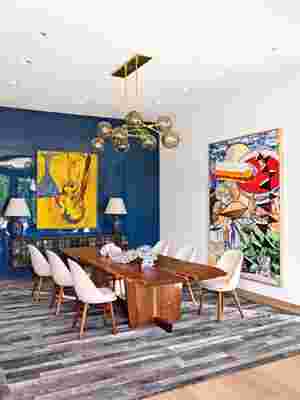A Look at George Nakashima’s Instinctual Woodworking
While interned in Idaho at Camp Minidoka during World War II, Japanese-American architect George Nakashima met master Japanese carpenter Gentaro Hikogawa. Using wood scraps and desert plants, they worked together to improve their stark living conditions. Nakashima, who had studied architecture at MIT and worked for Czech-American architect Antonin Raymond, also learned some traditional Japanese techniques, such as selecting timber and using butterfly joints.

A George Nakashima table in Julianne Moore’s New York City town house.
“He learned to improvise,” says his daughter, Mira Nakashima, who still has a small toy box he made for her at the camp. “You couldn’t draw something and then go buy materials. It was the other way around; the material came first.”
That resourcefulness laid the groundwork for a prolific practice in New Hope, Pennsylvania. (Raymond, who owned a farm there, took the Nakashimas in after their early release in 1943.) Working first with scrap wood and then with offcuts from a local lumberyard, Nakashima developed a style that celebrated nature’s imperfections.

Nakashima’s conoid cocktail table.
“The lumber was full of knots, cracks, and wormholes,” Mira Nakashima recalls. “Things ordinary furniture makers would throw away.” But her father embraced those flaws, giving rise to a look we now call live edge, where the natural texture of the tree’s exterior is left visible. Butterfly joints, a.k.a. Nakashima joints, were used as reinforcement on unruly bits or to book-match two slabs of wood (he favored black walnut and selected pieces on instinct alone) into long tabletops.

A Hamptons dining room designed by Fox-Nahem .
“He accepted and enhanced each piece of wood, with all of its imperfections,” says New York City architect and designer Stephanie Goto. (Michael Kors, Julianne Moore, and Joe Nahem of Fox-Nahem, are fans too.) Nahem, who has worked with the Nakashimas for more than three decades on many ambitious commissions (a kitchen island; a dining table for 18), calls that go-with-the-grain approach to woodworking, “a permanent part of the American design landscape. ” Mira Nakashima carries on that legacy today, playing matchmaker between client and wood. “Dad felt if you created something beautiful, it was beautiful forever.” nakashimawoodworkerom
For more insight on Nakashima's practice, read our edited conversation with Mira Nakashima.
Architectural Digest (AD) : Do you know when Nakashima designed his first table?
Mira Nakashima (MN): Dad worked at the Antonin Raymond office in Tokyo, that was one of his first jobs in 1934. I was trying to find out from Charlotte Raymond whether there were actual tables that he might have worked on when he was in Tokyo. I know he worked on some of the chairs. He was just a young architect at that time and Raymond was the boss so even if he made them he probably didn’t get credit for them. The old Raymond tables I’ve seen are quite rectilinear. Some of them have rounded legs but they’re primarily rectilinear. That’s what people did back then. That’s the type of material people were able to procure.
The other possibility is when, in 1941, he got married in L.A. and moved up to Seattle. Dad and Mom rented an apartment and Dad was able to work out an arrangement with the Maryknoll Lay Missioners boys club in Seattle. He worked in the basement of their building. They had set up a shop to teach the young men of their community how to do woodworking. Dad taught the boys in exchange for using the machinery. From what I’ve seen of those early examples, everything was, again, very rectilinear because that’s the kind of stock he was able to purchase and use. They were mostly just utilitarian. Nothing that was particularly fancy or designerly.
AD: What were some early influences on his style?
MN: There was one very significant incident in his life. In 1942 all the Japanese Americans on the west coast were incarcerated because of the war. Dad and the rest of the family were put into a camp in the Idaho desert. When he was in camp, he said, they were sort of apprentices to each other. There was another Japanese carpenter who had trained in Japan. He and Dad were working side by side to make the barracks more liveable. This fellow from Japan had all the skills and knowledge of the joinery and the way that they selected wood and used it in Japan. My father came from an architectural background. He knew a lot about structure and design. The two of them partnered at Minidoka and created some furniture there. I still have one of the toy boxes he made me when we were in camp. They couldn’t purchase good lumber so they used leftovers from the construction of the camp and something called bitterbrush that grew on the desert. They harvested that, polished it, and cut it into pieces they could use for furniture—mostly decorative elements. It wasn’t very big.
AD: Did that idea of creating beauty from what was around him influence his philosophy?
MN: Oh, absolutely. They had to learn to use whatever they could find. My father was trying to create a model apartment. I mean they were barracks. 10’ x 10’ rooms or something crazy. They were given potbelly stoves for heat and old military cots for beds and not a whole lot else. Anything else they made up of these leftover timbers and packing crates. Whatever they could find. That was a huge turning point. You had to learn how to improvise. You didn’t draw something on paper and then go buy materials. It was the other way around. The material first. They do that in Japan actually. When they’re building in the old traditional architectural mode they would spend years assembling the right size timbers before they started building. By that time the wood would be properly dried, going the right direction, the right species, and then they could build. They started with the material first.
AD: How long did the family stay at Minidoka?
MN: The Japanese Americans were supposed to be incarcerated until the end of the war, 1945, but my dad’s professor from MIT, where he went to architecture school and got his masters, contacted Mr. Raymond, his boss from Tokyo who had come to the U.S., set up his business, and bought a farm in Pennsylvania. That professor asked the Raymonds ‘Could you please sponsor the Nakashimas so they can get out of camp?’ By the grace of the Raymonds, we came to Pennsylvania in ‘43 rather than ‘45, when everyone else was released. Dad worked at Raymond’s farm as a chicken farmer. He couldn’t work as an architect because they were working on government projects so he, again, made stuff out of found objects—leftover barn doors, pieces of wood that weren’t used for construction. He worked with found objects, using the skill he had developed with the Japanese carpenter in the desert and he started making things in the old milk house when he wasn’t taking care of chickens. That was the second step of his improvisation.
In 1945 when we were released he got a little cottage down the road from where we are now. He didn’t come directly to this property and start building. He didn’t have any money. He rented this cottage which had been abandoned for many years. There wasn’t heat or running water. My mother cooked on a wood stove. That’s where we lived until Dad found the property we’re on now and he convinced the farmer who owned it to give him three acres in exchange for labor on his farm down the hill. He started building. At the old shop he would go to a lumber yard. He wanted to buy good lumber but he couldn’t afford it because it was too expensive.
But Dad went to the lumber yard and discovered that there were off-cuts. Back then, they quarter sawed most of the lumber so there were pieces they trimmed off that didn’t make good lumber. He was able to scavenge or purchase those and was able to start making furniture out of them. In his book he said he was a “rag picker”.
AD: He found beauty in the offcuts.
MN: It’s a very Japanese thing. You find beauty in imperfection. You celebrate it. In the beginning the lumber was full of flaws, there were knot holes and cracks and wormholes and all kinds of things that ordinary furniture makers would have thrown away. But he learned how to do the butterflies, probably from the carpenter in the camp. So he joined pieces with butterflies. He said in the beginning people didn’t understand what he was doing but after a while they paid extra for them.
AD: Who were his clients in the beginning?
MN: I know when Dad was at Raymond Farm he was introduced to Hans Knoll through the Raymonds. They tried to contract my father to join the first group of designers who worked with Knoll Studios back in the ‘40s. My father resisted for a while. Then he became friends with [Isamu] Noguchi and [Harry] Bertoia and he joined Knoll and designed several pieces of furniture and made them in his own shop for Knoll Studio. Until 1950 he was making the furniture in his own shop.
AD: When did you learn to make tables?
MN: Dad didn’t talk much. I learned more from the men that worked in the shop than I did from my dad. He made the larger dining tables and bigger coffee tables and chair seats and things. There were usually leftovers. And because they were always very frugal and didn’t want to waste anything, there were a lot of offcuts from the shop sitting around, waiting to be used. I didn’t actually make any useful furniture until I came back in 1970. I worked primarily with my mother in the office which I didn’t really enjoy. Eventually they hired a secretary and I was able to work with Dad. I did drawings. I went to architecture school so I knew how to draw but I was afraid I would forget how if I had to work in the office too long. There were these leftover pieces of wood in the shop and Dad said ‘Why don’t you make something with these?’ They became pencil holders, candle holders. I made them, drilled holes in them, polished them up and put them in the showroom. I would make three-legged tables out of the larger pieces. The smallest ones we call the plank stool. That’s a design that Dad started when he was still in Seattle. It changed a little as time went on. There were specific angles and dimensions for the legs, placement of the legs. He did help me with that. He taught me how to make sure the table balanced after it had its legs on. I went onto bigger and bigger three-legged tables and finally made my first big coffee table before getting sucked into the office again.
AD: How would you describe his process of choosing wood?
MN: He was pretty instinctive about wood selection. I remember when people would come into the studio they would say ‘We need a table this big and this wide,’ or, ‘We just have a dining room, what would you like to make us?’ And he would look at them and think about his woodpile and go out and find one set of boards that he thought would be appropriate for them. If they didn’t like it he might show them one more set of boards, if he had it available. It takes a lot of faith. A raw board never looks like a finished table. They trusted him. They trusted his judgement. He’d draw a pencil sketch, usually pretty rough. He’d give them the pencil sketch, tell them how much it would cost and usually they would put the money down and six months or a year later he would go into production.
AD: Where did he source the wood?
MN: We had a very personalized way of procuring lumber. In the very beginning he would get the offcuts from the lumber yard. As time went on, he made friends with the loggers in the area. They would take down logs and he would accompany them to the saw mill and oversee the milling. He had a very good idea of where these logs came from and what they looked like because he oversaw the milling of them before they were dry enough to make into furniture. He did this for years. By the end of his life there were about 100 walnut logs that he had purchased and milled. There was this one lumber yard in Philadelphia who agreed to process all of our lumber, to kiln dry it and send it down to us as we needed it. When it came in Dad would be out there in the lumber shed, standing on top of the pile, looking over every single piece of lumber that came off that truck. At least twice he had handled it, was familiar with it, and remembered it. I think that’s why he could say, ‘Oh yeah I have that perfect pair of boards for your table.’
AD: He had an encyclopedic memory of each board.
MN: Yeah pretty much.
AD: I have a question about the butterfly joint. In the early days Nakashima used them to repair pieces of wood that were not ideal. Once he had his pick of wood, did the use change?
MN: Even though we have specially selected the lumber and been very careful about drying it, most of what we use is Pennsylvania black walnut which is pretty quirky. It has its own personality and grows in funny directions. There are cracks that result no matter what we do. Every now and then we get a client that says ‘I don’t want any butterflies,’ and we have to look really hard to find wood that doesn’t have cracks or need butterflies. Sometimes we can do it. The butterflies are generally used down the center of a dining table. We book-match two planks that were cut side by side in the same log but we leave an eighth of an inch between the two planks and join them with a butterfly according to the length of the table. Whenever there are really obvious cracks that look like they might get worse, we join them with butterfly joints. It becomes a decorative point but we don’t do them just for decoration. We use them when it’s structurally necessary.
AD: How do you advise customers to care for the tables?
MN: We only use a rubbed oil finish. We apply a pure tung oil finish on tabletops, sometimes six or seven coats. We allow it to dry between each coat so that it’s not impervious. Dad didn’t want furniture to be impervious to water or people or whatever. He felt the wood has a life of its own and should not be separated from the people or environment where it’s used. You do have to be a little more careful than something with a plastic finish on it. If you spill something on it you need to wipe it up as soon as you realize you’ve spilled it. We have an upkeep oil—a combination of tung oil varnish and other things—we give it to all of our clients.
AD: Nakashima pieces really work so wonderfully in every type of interior.
MN: Dad did different designs and chose different woods for people who had different things. One of our friends had a Persian rug and she lived in a renovated red barn with a bunch of other antiques. He selected English oak burl for her coffee table and it fit right in. Or sometimes everything is white and he would choose a wood or a design that harmonized with it. People sometimes send us floor plans with dimensions so we can figure out what will look best in the space. Someone called the other day and he said ‘I can’t decide which piece of wood I want, can you help me?’ He put me on FaceTime and took me all around his room. It was very helpful. I could see what he had in the room, how big it was. He showed me the piece of art that was hanging over it. That was the first time I had done a FaceTime review of somebody’s space but it worked.
AD: So many people have lived with and loved Nakashima tables. Why do you think they are so timeless?
MN: I think it’s the way my father would have liked it. He felt if you created something beautiful it was beautiful forever. It was timeless. That was his intent. When he started his business he said he was basically doing it as an antidote to modern design and mass production. He felt that the human aspect of making things by hand should be retained and respected and utilized to its fullest. There’s an individualized feel about each piece—not only from the wood itself but the design itself and from the maker himself. It’s a very personal process.